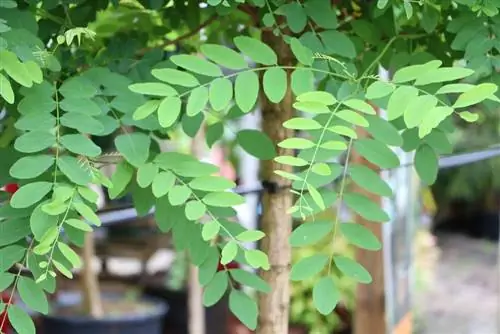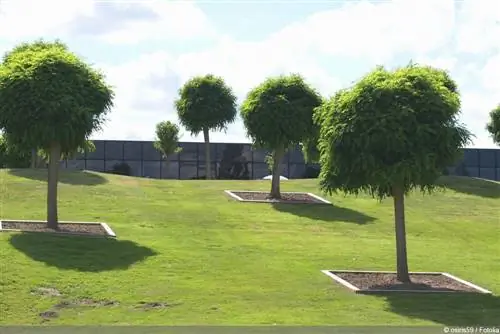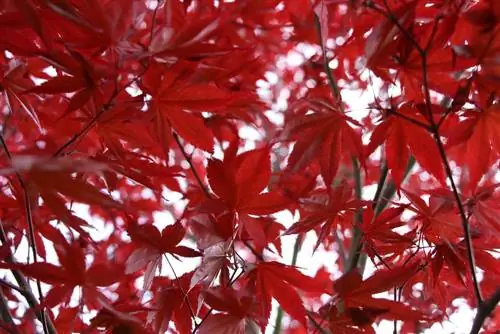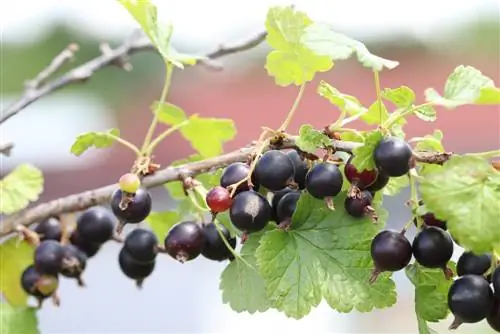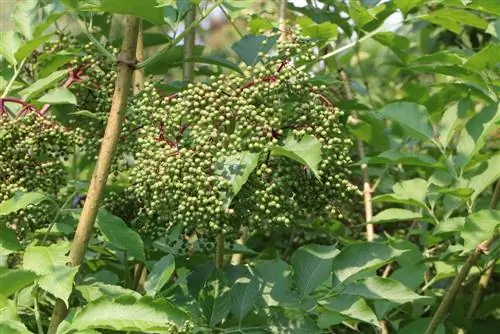- Author admin [email protected].
- Public 2023-12-17 03:39.
- Last modified 2025-01-24 12:45.
The black locust is considered an invasive neophyte that also reproduces quickly through self-sowing and root shoots. For this reason it is not advisable to plant the tree! A good alternative is the ball locust, which cannot reproduce on its own. The black locust produces several thousand white or pink flowers in May to June, which are particularly popular with insects. It can live up to 200 years and reach a height of up to 20 meters.
Profile
The ball robinia is a particularly popular representative of the twenty species of robinia. It is a refined form of the common robinia. It is a small, slow-growing tree that is reminiscent of the acacia tree due to its feather-like leaves. This is why you often find the names “false acacia” or “pseudo acacia”. The spherical robinia forms a small, spherical crown that has many branches and is tightly closed. Its crown consists of oval leaves, the upper side of which is colored blue-green. The underside is light green in color.
In autumn, the tree impresses with its bright yellow, red or golden brown coloring and therefore attracts everyone's attention, not just in summer. The fruits of this tree hang from the branches in the form of pods and each contain 4 to 10 seeds. The pods often remain on the tree even in winter. If the crown is not cut, it will be around 4 to 5 meters in size.
The tree is poisonous in all parts, the concentration of poison is particularly strong in the seeds and bark. In contrast to its wild form, the ball locust has no thorns. In addition, it does not flower and therefore cannot spread uncontrollably. However, it emits a very strong scent. The particularly hard robinia wood is very popular because it does not weather and has similar uses to tropical wood.
Location
The ball locust is particularly undemanding and easy to care for. It thrives optimally on nutrient-rich, loose clay soil. But dry sand and gravel soils are also suitable. The tree tolerates limestone soils as well as heavy and impermeable soils less well. The plant cannot tolerate waterlogging. The ball locust can often be found in parks or pedestrian zones, but it can also often be seen in not too small gardens, entrance areas or driveways. It is important to plant the tree in a place that is somewhat sheltered from the wind, as the delicate branches can easily break if the wind is too strong.
The ball locust is very robust and loves a warm location. It has no problems with intense sunlight and can therefore withstand full sun. The ball locust also feels at home in pots and containers.
Cut
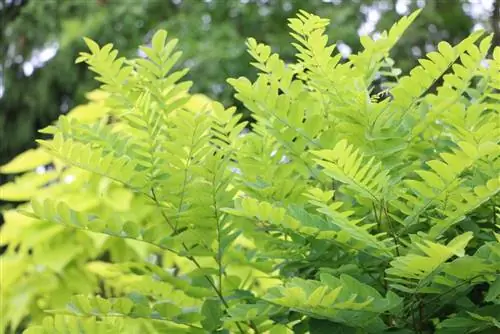
The crown of the plant, which is very easy to cut, can be cut to any size. If pruning is done in autumn, the growth density of the crown is promoted. However, the branches can be cut all year round. Under no circumstances should the tree be cut during the budding period. Exceptions are damaged branches, which would otherwise be a target for pests and diseases. However, pruning is not absolutely necessary as the robinia tree is naturally round in shape. If a cut is still planned, the crown should only be thinned out. Damaged branches are cut off directly at the base. For aesthetic reasons it is sometimes necessary to cut off he althy branches.
Under certain circumstances it may be necessary to shorten the branches of the entire crown. It is possible to cut off the branches up to two thirds of their length. For example, if the tree is badly damaged after a storm, radical pruning may be necessary. In this case, however, it is important to cut off the tree above the grafting point. Otherwise, only wild branches of the tree will sprout and spherical growth is no longer possible. The resulting cuts should be closed with a wound closure agent.
Propagation
This tree is propagated through grafting. This ensures that the tree trunk only grows in width, but not in height, and only the crown changes size. When buying the spherical robinia, you should definitely choose the right height.
Diseases and pests
The tree is often attacked by stubborn lice, which can cause it to have yellow, wilted leaves even in summer, which then fall off. The pests can be eradicated using chemical agents. The robinia leaf miner can also be found every now and then on the leaves of the tree, whose larvae cause the leaves to turn yellow and fall off. In most cases, no control is necessary because the tree can usually deal with this pest on its own. An occasional disease of the locust locust is Phloespora leaf spot. This is a fungal pathogen that causes small 0.5 to 1 cm brown spots on the leaves. To minimize the risk of infection, all affected leaves should be removed in autumn. If the shoots are also affected, the crown of the tree must be cut back.
Planting Tips
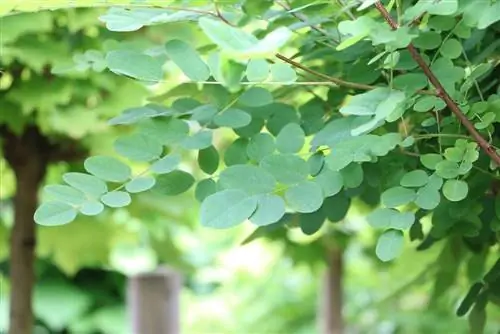
When planting this plant, the following things should be taken into account:
- Planting time: best from September to April, this is especially true for bare-root plants
- Preparation of the soil: heavily compacted soils should be loosened
- Fixing: during the first two years with stakes
- Protecting the trunk: Jute bandages protect against damage to the trunk
- Aids: Rooting aids from the trade ensure better root formation and thus make growth easier
- Watering: give lots of water at first
What you should know about robinia in brief
- The black locust is also known as false acacia and false acacia and is originally from North America.
- It is a deciduous tree that has a rounded, umbrella-like crown.
- Overall, the robinia can reach a size of 20 to 25 meters.
- Their bark is green-brown and dark brown and deeply furrowed. The branches are twisted on the short trunk.
- The robinia is generally hardy. It only turns green very late in spring.
- Their leaves are unpaired “pinnate” and reach a length of up to 30 centimeters.
- From May to June the black locust is in bloom and has a strong bergamot-like scent.
- The grapes contain a lot of nectar and are therefore visited by many insects.
- Humans spread the rather undemanding robinia to numerous areas.
- Today it can be found in Europe, North Africa and West and East Asia.
In the 18th century, the black locust was discovered for timber construction and is still often used today as a tree species for the reforestation of destroyed forests due to its low demands on the soil. Robinias are also used as garden plants, avenue trees and city trees, which is why many cultivars have since emerged. Robinias tolerate the dry urban climate well and are insensitive to smoke, dust and soot.
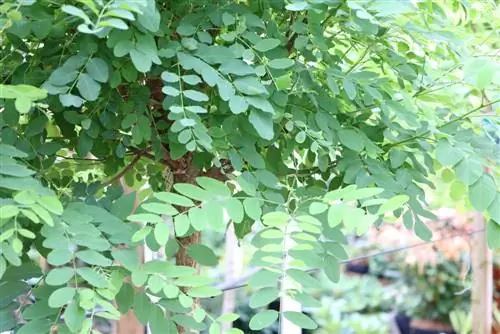
Conclusion
- One of the cultivated forms is the locust locust, which represents a mutation.
- This suppresses the preference for growth of the main shoot, resulting in a spherical to hemispherical crown structure.
- Unlike other trees of its kind, the ball locust has no thorns and reaches a height of less than six meters.
- It only grows 15 centimeters per year.
- Robinias must be cut regularly so that they are sufficiently ventilated and to avoid damage from wind, age and snow.
- To do this, the ball locust tree is thinned out a little and shortened. The locust locust is very pretty to look at and is used as an ornamental tree.
- The ball locust is ideal as a garden tree that can stand freely in a meadow or in a pot.
The decorative plant is very robust and requires little care. It is therefore ideal for beginner gardeners who have little experience in pruning plants and want to enjoy a beautiful tree for many years.

